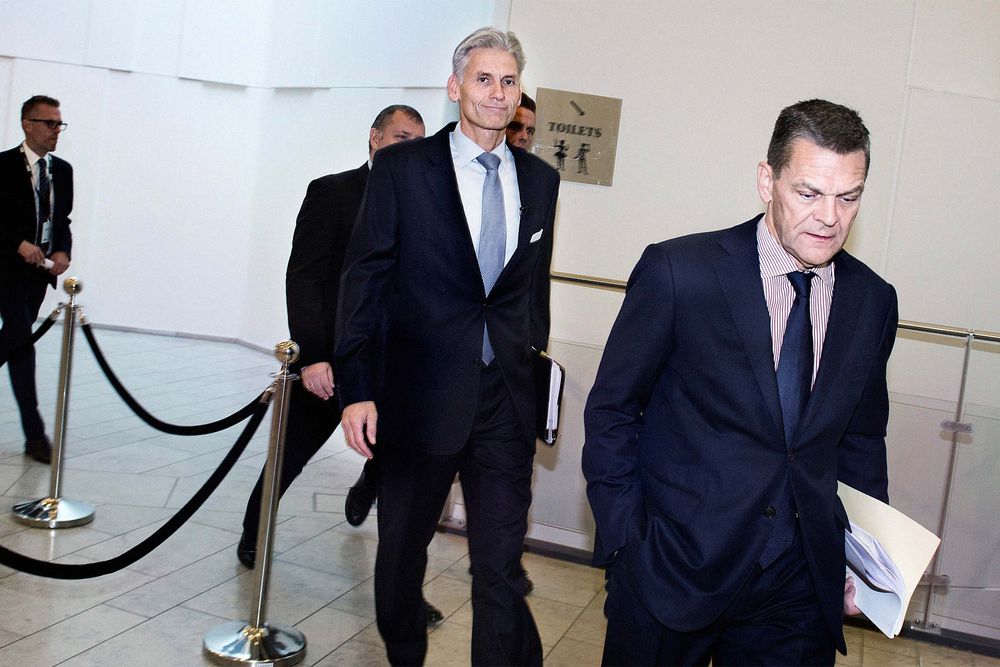
Danske Bank CEO Thomas Borgen and Chairman Ole Andersen arrive at a Sept. 19 press conference in Copenhagen to address the bank’s money laundering scandal. Photographer: Liselotte Sabroe/Ritzau Scanpix/via Reuters
Danske Bank A/S, founded in Copenhagen in the 1870s, has rarely made waves outside Denmark. That changed when the bank revealed the scale of what may prove to be one of Europe’s biggest and most brazen cases of money laundering.
The Danske revelations are just the latest example of how much needs to be done to stop bad actors from funneling ill-gotten gains into the European Union, cleansing the money in the process so it can be spent without raising alarms. Seven months ago it was Latvia, Estonia’s neighbor, caught in the media and regulatory glare after the U.S. Department of the Treasury accused the country’s third-largest lender of acting as a laundromat for cash. That bank denied wrongdoing and has gone into liquidation. Earlier in September, Dutch giant ING Groep NV agreed to pay €775 million to settle a probe by the Netherlands prosecutor into misdeeds including money laundering.
On Sept. 24, the German market watchdog ordered Deutsche Bank AG to improve controls against money laundering and terrorism financing and assigned audit firm KPMG to oversee its efforts. That’s after Germany’s largest bank paid more than $600 million in fines to U.S. and U.K. regulators last year for helping Russian clients take as much as $10 billion out of their country. The string of cases gives a whack-a-mole quality to Europe’s enforcement efforts.
With no centralized European authority tasked with rooting out money laundering, it’s usually left to national regulators and local police to do the job. The crackdown in Latvia was led by the U.S., while the investigation in Estonia was spurred by reporting in Danish newspaper Berlingske—rather than by national or EU officials.
As officials seek to apportion blame, the EU is looking into whether Danske Bank’s supervisors did enough to prevent the misbehavior. Denmark’s Financial Supervisory Authority said it was contacted on Sept. 24 by the European Banking Authority, which oversees national bank watchdogs. It wants the Danish regulator to explain what it did to try to ensure Danske Bank was meeting anti-money-laundering requirements. The FSA issued a scathing report on the lender’s actions in May.
Danske is Denmark’s biggest bank and, until recently, was perhaps best known for its cozy ties to the country’s staid corporate establishment. Its largest shareholder, with a 20 percent stake, is A.P. Møller Holding A/S, the investment arm of the foundation that controls A.P. Møller-Maersk A/S, the world’s largest container shipping line.
So how did the bank entangle itself with suspicious transactions in Estonia? In the 87-page internal report, Danske traces the lapses to the purchase of Finland’s Sampo Bank in 2007. As part of that deal, completed on the cusp of the global financial crisis, Danske acquired the unit in Estonia, a nation of 1.3 million people abutting Russia. While the tiny Baltic state broke away from the Soviet Union in 1991 and joined the EU in 2004, a quarter of the population is ethnically Russian. Cultural and economic ties to its former overlord remain.
Among a series of missed opportunities, according to the report, Danske Bank ignored warnings as far back as 2007 from Estonia’s regulator and the Russian central bank that the unit was being used for tax evasion and money laundering. The bank also failed to properly investigate a whistleblower report from 2013. By the end of that year, the nonresident portfolio at Danske’s unit—those accounts held by customers outside the country—amounted to 44 percent of all such deposits at Estonia’s banks, up from 27 percent in 2007. Danske decided to wind down the nonresident portfolio in the second half of 2015. But it really began to dig into the matter only in response to an article in Berlingske last year.
By the time of the report’s release, just over 40 percent of the foreign customers—those identified as most suspicious—had been reviewed, with some 8,800 still to be examined. Eight former employees of the Estonian branch were reported to the police by Danske on suspicion of having colluded with customers. “The bank has clearly failed to live up to its responsibility in this matter,” Chairman Ole Andersen said in a statement the week the report came out.
The U.S. Treasury has been looking closely at the allegations, Assistant Secretary for Terrorist Financing Marshall Billingslea told Berlingske on Aug. 30. Britain’s National Crime Agency signaled it’s examining the role of U.K.-registered companies in the scandal, after Danske identified the country as the second-biggest source of foreign clients at the Estonian branch after Russia.
The bank could face fines as high as $1.7 billion after the most recent disclosures, analysts at Svenska Handelsbanken AB estimated in a note. “It’s taken us a decade to resurrect faith in the financial industry” following the global crash of 2008, says Lidegaard, the former foreign minister. “This case will come back to haunt us for many years as we rebuild faith once more.”

